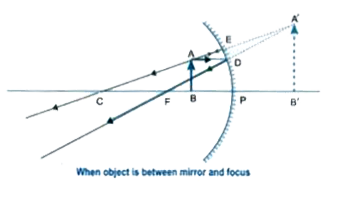A virtual, erect and magnified image of an object is to be produced with a concave mirror of focal length 12 cm. Which of the following object distance should be chosen for this purpose?
10 cm
14 cm
18 cm
24 cm
The correct Answer is:A
To solve the problem of finding the object distance (u) for a concave mirror that produces a virtual, erect, and magnified image, we can follow these steps:
1. Identify the given data:
- Focal length (f) of the concave mirror = -12 cm (negative because it is a concave mirror).
- The image is virtual, erect, and magnified.
2. Understand the characteristics of the image:
- A virtual image formed by a concave mirror occurs when the object is placed between the focal point and the mirror (i.e., u < f).
- Since the image is virtual, the image distance (v) will be positive.
3. Use the mirror formula:
The mirror formula is given by:
1f=1v+1u
Rearranging this gives:
1u=1f−1v
4. Substituting known values:
Substitute f=−12 cm into the equation:
1u=1−12−1v
5. Determine the sign of v:
Since the image is virtual, v is positive. Therefore, we can express 1v as a positive value.
6. Establish conditions for u:
For a virtual image, we know that:
1u=1−12−1v
Since 1v is positive, we can conclude that:
1u>1−12
This implies that u<−12 cm (since u is always negative).
7. Finding the range for u:
The condition u<−12 cm indicates that the object distance must be less than the absolute value of the focal length. Therefore, we need to find an object distance that is less than 12 cm in magnitude.
8. Choose the correct option:
Among the options provided, we need to select the one that is less than 12 cm (in the negative direction). The only option that fulfills this condition is -10 cm (or 10 cm in absolute terms).
Conclusion:
The object distance that should be chosen for producing a virtual, erect, and magnified image with a concave mirror of focal length 12 cm is 10 cm.
- Focal length (f) of the concave mirror = -12 cm (negative because it is a concave mirror).
- The image is virtual, erect, and magnified.
- A virtual image formed by a concave mirror occurs when the object is placed between the focal point and the mirror (i.e., u < f).
- Since the image is virtual, the image distance (v) will be positive.
The mirror formula is given by:
1f=1v+1u
Rearranging this gives:
1u=1f−1v
Substitute f=−12 cm into the equation:
1u=1−12−1v
Since the image is virtual, v is positive. Therefore, we can express 1v as a positive value.
For a virtual image, we know that:
1u=1−12−1v
Since 1v is positive, we can conclude that:
1u>1−12
This implies that u<−12 cm (since u is always negative).
The condition u<−12 cm indicates that the object distance must be less than the absolute value of the focal length. Therefore, we need to find an object distance that is less than 12 cm in magnitude.
Among the options provided, we need to select the one that is less than 12 cm (in the negative direction). The only option that fulfills this condition is -10 cm (or 10 cm in absolute terms).
The object distance that should be chosen for producing a virtual, erect, and magnified image with a concave mirror of focal length 12 cm is 10 cm.
Topper's Solved these Questions
- BOOK - MCGROW HILL PUBLICATIONCHAPTER - REFLECTION OF LIGHT EXERCISE - HIGHER ORDER THINKING QUESTIONS10videos
REFLECTION OF LIGHT
- BOOK - MCGROW HILL PUBLICATIONCHAPTER - MOTIONEXERCISE - HIGHER ORDER THINKING QUESTIONS48videos
MOTION
- BOOK - MCGROW HILL PUBLICATIONCHAPTER - REFRACTION OF LIGHTEXERCISE - HIGHER ORDER THINKING QUESTIONS37videos
REFRACTION OF LIGHT
Similar Questions
Knowledge Check
- Question 1 - Select One
A virtual, erect and magnified image of an object is to be produced with a concave mirror of focal length 12 cm. Object may be placed at a distance of
A10 cm from the mirrorB15 cm from the mirrorC24 cm from the mirrorD48 cm from the mirror - Question 2 - Select One
At what position does an object needs to be placed so that a concave mirror gives an image which is virtual in nature, erect and magnified as compared to the object?:
Aat infinityBbetween P and FCbeyond CDbetween C and F - Question 3 - Select One
Image formed by a concave mirror of focal length 6 cm , is 3 times of the object, then the distance of object from mirror is
A−4cmB8cmC6cmD12cm
We wish to obtain an erect image of an object, using a concave mirror of focal length 15 cm. What should be the range of the distance of the object from the mirror? What is the nature of the image Is the image larger or smaller than the object? Draw a ray diagram to show the image formation in this case.
 View Solution
View SolutionWe wish to obtain an erect image of an object, using a concave mirror of focal length 15 cm. What should be the range of distance of the object from the mirror? What is the nature of the image? Is the image larger or smaller than the object? Draw a ray diagram to show the image formation in this case.
View SolutionAn object is placed at 50 cm in front of a concave mirror of focal length 25 cm. What is the nature of the image produced by the mirror ?
View SolutionAn object is placed at a distance of 20 cm from the pole of a concave mirror of focal length 10 cm. The distance of the image formed is
View SolutionAn object is placed at a distance of 40 cm in front of a concave mirror of focal length 20 cm the image produced is
View Solution

